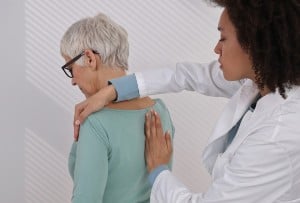Cervical dystonia is a movement disorder that causes the head to be pulled back, to the side or forward.
It can be debilitating if untreated, but a neurologist can help with treatment options including Botox and physical therapy.
Dr. Jesus Martinez said most patients respond well and can lead a healthy life.
Most people have experienced a muscle cramp or spasm. If they linger and get worse, causing pain and improper movement and postures, it might be a sign of a movement disorder.
When that happens, patients should seek medical help from a neurologist.
Movement disorders are neurological conditions. Dystonia, one of the most common, causes the muscles to contract uncontrollably. The body is forced to twist. This leads to improper posture or repetitive movements.
Jesus Martinez, MD, is a neurologist at Regional One Health’s East Campus. He helps patients with dystonia and other movement disorders. “Dystonia can be very painful,” he said. “In adults, it’s often related to the neck muscles, and the head will be pulled back, to the side or forward.”
This is called “cervical dystonia.” It is the most common type of dystonia.
Dr. Martinez said it can be serious and even disabling: “When the head is pulled forward, it can hamper communication and the ability to see and eat.”

Cervical dystonia can start with involuntary muscle contractions and pain in the neck and shoulders.
The condition usually occurs between age 40 and 60. More women than men are affected, and it can run in families.
Dr. Martinez said symptoms often start gradually and then get worse before leveling off.
Involuntary muscle contractions in the neck are the main red flag. Other symptoms include:
- A burning pain in the neck and shoulders
- Severe headache
- Tremors in the head or hand
- A raised shoulder
When patients complain of those symptoms, Dr. Martinez conducts a thorough physical exam. If the patient is suffering from cervical dystonia, the causes can vary.
Primary cervical dystonia is a problem with how the brain signals the muscles to move.
Secondary cervical dystonia is the result of another condition. There are several common causes:
- Stroke
- A traumatic brain injury or injury to the neck or shoulders
- Parkinson’s disease
- Reaction to a drug

Treatment for cervical dystonia can include Botox and physical therapy. Most patients respond well and lead a healthy life.
Once Dr. Martinez reaches a diagnosis, he can help patients with their symptoms. While there is no cure for cervical dystonia, he said patients often do well under treatment.
“These patients respond very nicely to Botox injections,” he said. “It relaxes the neck muscles so patients have a more normal posture and less pain.”
There are also oral medications that help, and Dr. Martinez refers patients to physical therapists at the East Campus.
He said therapy can stretch and strengthen the muscles in the neck. This improves posture and movement and helps ease pain.
He advises patients with cervical dystonia to avoid stress and get plenty of sleep. Exhaustion and stress can aggravate the condition.
Patients with cervical dystonia can lead typically healthy lives with the help of a neurologist.